Over 4,200 volunteers headed out on Saturday, April 11th to help remove litter, beautify green spaces, and share in a day of service.
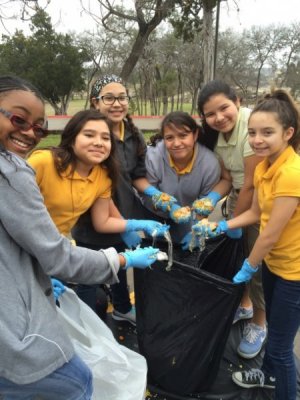 The discovery came early spring, when we were busy eating bananas as an afterschool snack. As the bananas disappeared and bellies filled, the Green Teens discussed what they could do with the leftover banana peels. One of the Green Teens mentioned putting food waste into a separate compost bin at their elementary schools, and they all wondered why that option was no longer available in middle school.
The discovery came early spring, when we were busy eating bananas as an afterschool snack. As the bananas disappeared and bellies filled, the Green Teens discussed what they could do with the leftover banana peels. One of the Green Teens mentioned putting food waste into a separate compost bin at their elementary schools, and they all wondered why that option was no longer available in middle school.
With faces full of curiosity, our spring schedule was decided. We would track down our cafeteria food waste and see just how much waste was fated for the landfill when composting was not on the menu. To begin, we followed our noses right to the school dumpster—the temporary resting place for cafeteria food before it is sentenced to life in a local landfill. The students extracted food waste from five trash bags. The food waste weighed in at an average of five pounds per bag. Disgusted by the quantity of waste and by the smell, the Green Teens rallied for change.
They pieced through many waste diversion options and decided that a worm compost bin would recycle their discarded food and suit their garden best.
Once they envisioned this powerful change, they shared their vision with EcoRise Youth Innovations to receive a sustainability grant. Fully funded they set out to welcome their food waste to stay a while, to keep the school waste in place. The Green Teens drilled, painted, and decorated a 4×2 wooden worm compost bin for their garden with power tools and paint brushes in hand. The worm habitat was complete.
Using these foolproof instructions, you can follow in our footsteps and create a worm compost bin of your own.
The worms went on completing the hard work of eating our food scraps and transforming it into nutrient rich soil also known as worm castings aka worm poop.

After two months of care, our project was complete. It was time to showcase our work and teach visitors all that we had learned about nutrient cycling. During our school showcase, the Green Teens shared the story of food to soil and back again.
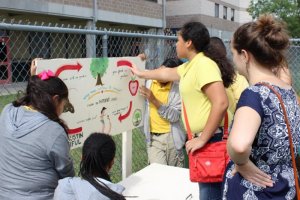
But the fun wasn’t over yet. As an EcoRise grant winner, we also had the opportunity to showcase our project to a wider audience along with fourteen other grant winners. If models, hand-drawn infographics, and microscopes inspired us then what better way to model our vermicompost display. Kiana Thomas, Kasey Williams, and Pablo Aleman carried the message to City Hall as Green Teens representatives for Paredes Middle School.
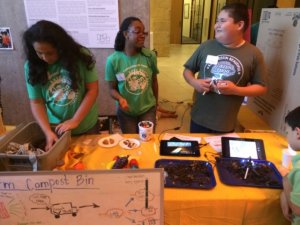
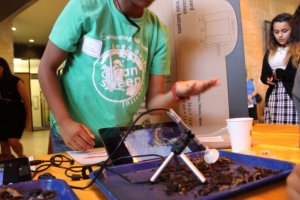
As visitors ebbed and flowed, we made sure to share stories of building and rebuilding the compost bin and smiles that trumped over the crowd. Many people walked away with wide eyes realizing our worms’ potential and how the simple solution could be used in their homes as well.
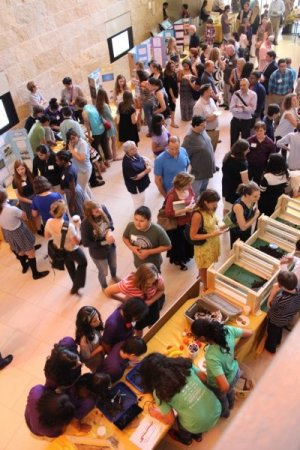
Over the course of the project, thirty two Paredes students contributed their time and talent to make the worm bin a reality. Special recognition goes to Kiana Thomas, Kasey Williams, and Pablo Aleman who received awards for their ongoing leadership and presentation skills.
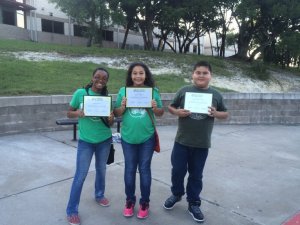
Throughout the process, the Paredes Green Teens didn’t mind getting their hands dirty and our food now follows suit—in the compost bin it doesn’t mind becoming soiled. Come September, we will be giving back to our food system by incorporating the compost into our garden. The cycle continues, all thanks to the hard work and positive outlooks of our Green Teens.
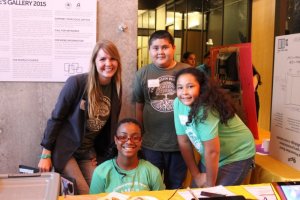
Keep Austin Beautiful Environmental Educator Adrianne stands proudly with her students after a wonderfully successful City Hall showcase.







